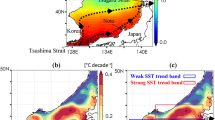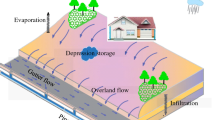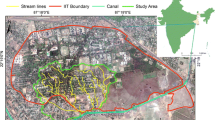Abstract
The coast of Bangladesh is funnel shaped. The narrowing of the Meghna estuary along with its peculiar topography creates a funneling effect that has a large impact on surge response. In order to have an accurate estimation of surge levels, the impacts of the estuary should be treated with due importance. To represent in detail the real complexities of the estuary, a very high resolution is required, which in turn necessitates more computational cost. Considering the facts into account, a location specific vertically integrated shallow water model in cylindrical polar coordinates is developed in this study to foresee water levels associated with a storm. A one-way nested grid technique is used to incorporate coastal complicities with minimum cost. In specific, a fine mesh scheme (FMS) capable of incorporating coastal complexities with acceptable accuracy is nested into a coarse mesh scheme (CMS) covering up to 15∘N latitude in the Bay of Bengal. The coastal and island boundaries are approximated through appropriate stair step representation and the model equations are solved by a conditionally stable semi-implicit finite difference technique using a structured C-grid. Numerical experiments are performed using the model to estimate water levels due to surge associated with the April 1991 and AILA, 2009 cyclones, which struck the coast of Bangladesh. Time series of tidal level is generated from an available tide table through a cubic spline interpolation method. The computed surge response is superimposed linearly with the generated time series of tidal oscillation to obtain the time series of total water levels. The model results exhibit a good agreement with observation and reported data.









Similar content being viewed by others
References
Government of Bangladesh (GOB) (2008) Cyclone Sidr in Bangladesh: damage loss and needs assessment for disaster recovery and reconstruction. Government of Bangladesh, Dhaka
Hossain MZ, Islam MT, Sakai T, Ishida M (2008) Impact of tropical cyclones on rural infrastructures in Bangladesh. Agric Eng Int 10(2):1–13
Jain SK, Agarwal PK, Singh VP (2007) Hydrology and water resources of India. Springer, Dordrecht, p 308
Jelesnianski CP (1965) A numerical calculation on of storm tides induced by a tropical storm impinging on a continental shelf. Mon Weather Rev 93:343–358
Johns B, Rao AD, Dube SK, Sinha PC (1985) Numerical modeling of tide surge interaction in the bay of Bengal. Philos Trans R Soc Lond A 313:507–535
Khalil GM (1992) Cyclones and storm surges in Bangladesh: some mitigative measures. Nat Hazards 6:11–24
Khalil GM (1993) The catastrophic cyclone of April 1991: its impact on the economy of Bangladesh. Nat Hazards 8:263– 281
Miyan MA (2005) Cyclone disaster mitigation in bangladesh. South asian disaster management center (SADMC). Available (December 2008). http://www.researchsea.com/html/article.php/aid/141/cid/6?PHPSESSID=36f90mj40it9tvbao1otg8ljj7
Murty TS, Flather RA, Henry RF (1986) The storm surge problem in the Bay of Bengal. Prog Oceanogr 16:195–233
Murty TS, EI-Sabh MI (1992) Mitigating the effects of storm surges generated by tropical cyclones: a proposal. Nat Hazards 6:251– 273
Nash S (2010) A development of an efficient dynamically-nested model for tidal hydraulics and solute transport (PhD). National University of Ireland, Galway
Paul BK (2009) Why relatively fewer people died? The case of Bangladesh’s cyclone Sidr. Nat Hazards 50:289–304
Paul GC, Ismail AIM (2012a) Numerical modeling of storm surges with air bubble effects along the coast of Bangladesh. Ocean Eng 42:188–194
Paul GC, Ismail AIM (2012b) Tide-surge interaction model including air bubble effects for the coast of Bangladesh. J Frankl Inst 349:2530–2546
Paul GC, Ismail AIM (2013) Contribution of offshore islands in the prediction of water levels due to tide-surge interaction for the coastal region of Bangladesh. Nat Hazards 65:13–25
Paul GC, Ismail AIM, Karim MF (2014) Implimentation of method of lines to predict water levels due to a storm along the coastal region of Bangladesh. J Oceanogr 70:199–210
Paul GC, Ismail AIM, Rahman A, Karim MD, Hoque A (2016) Development of tide–surge interaction model for the coastal region of Bangladesh. Estuar Coasts 39:1582–1599
Powell MD, Vickery PJ, Reinhold TA (2003) Reduced drag coefficient for high wind speeds in tropical cyclones. Nature 422:279– 283
Rahman MM, Paul GC, Hoque A (2013) Nested numerical scheme in a polar coordinate shallow water model for the coast of Bangladesh. Ocean Eng 17:37–47
Rao AD, Jain I, Murthy MVR, Murty TS, Dube SK (2009) Impact of cyclonic wind field on interaction of surge-wave computations using finite-element and finite-difference models. Nat Hazards 49:225–239
Roy GD (1995) Estimation of expected maximum possible water level along the Meghna estuary using a tide and surge interaction model. Environ Int 21:671–677
Roy K, Kumar U, Mehedi H, Sultana T, Ershad DM (2009) Initial damage assessment report of cyclone Aila with focus on Khulna District. Unnayan Onneshan- Humanitywatch-Nijera Kori, Khulna, Bangladesh, p 14
Roy C, Kovordanyi R (2012) Tropical cyclone track forecasting techniques - a review. Atmos Res 104–105:40–69
Roy GD, Kabir ABMH, Mandal MM, Haque MZ (1999) Polar coordinate shallow water storm surge model for the coast of Bangladesh. Dyn Atoms Ocean 29:397–413
Roy C, Sarkar SK, Aberg J, Kovordanyi R (2015) The current cyclone early warning system in Bangladesh: providers’ and receivers’ views. Int J Disaster Risk Manage 12:285–299
Sinha PC, Jain I, Bhardwaj N, Rao AD, Dube SK (2008) Numerical modeling of tide-surge interaction along Orissa coast of India. Nat Hazards 45:413–427
Talukder J, Roy GD, Ahmed M (1992) Living with cyclone. Community Development Library, Dhaka
White GF, Haas JE (1975) Assessment of research on naturtal hazards. MIT Press, Cambridge
Yu FJ, Zhang ZH (2002) Implementation and application of a nested numerical storm surge forecast model in the East China Sea. Acta Oceanol Sin 21:19–31
Acknowledgments
The authors are grateful to their anonymous referee and the editors for their generous comments and appreciated contributions for improving the manuscript. This work is partially supported by a grant from the Ministry of Science and Technology of Bangladesh with G.O. No. 39.009.002.01.00.053.2014–2015/BS–1/ ES–34 and a grant from the Dean of the faculty of science of the University of Rajshahi, Bangladesh with No. 673 −5/52/UGC Project/Science −8/2014. The authors are also thankful to Mr. Md. Mamunur Rasid and Mr. Md. Morshed Bin Shiraj; M.Sc. thesis students, Department of Mathematics, University of Rajshahi, Bangladesh for their help in constructing some figures. Some data from a study of late Professor G.D. Roy were used in this study for comparison and one of the researchers was permitted by Professor G.D. Roy (Late) to use those data.
Author information
Authors and Affiliations
Corresponding author
Ethics declarations
Conflict of interests
The authors declare that they have no conflict of interest.
Rights and permissions
About this article
Cite this article
Paul, G.C., Murshed, M.M., Haque, M.R. et al. Development of a cylindrical polar coordinates shallow water storm surge model for the coast of Bangladesh. J Coast Conserv 21, 951–966 (2017). https://doi.org/10.1007/s11852-017-0565-x
Received:
Revised:
Accepted:
Published:
Issue Date:
DOI: https://doi.org/10.1007/s11852-017-0565-x




